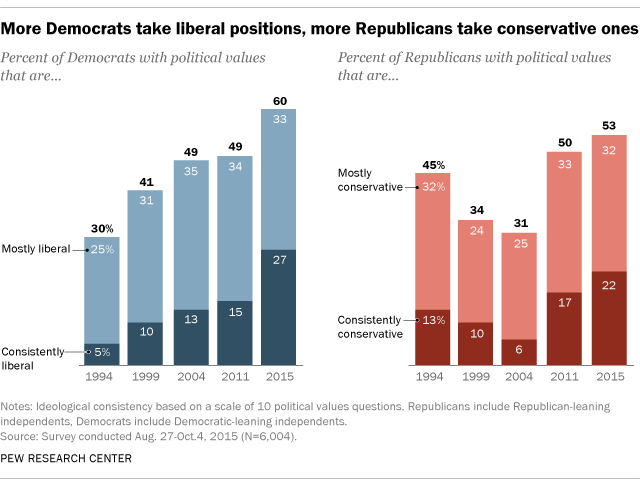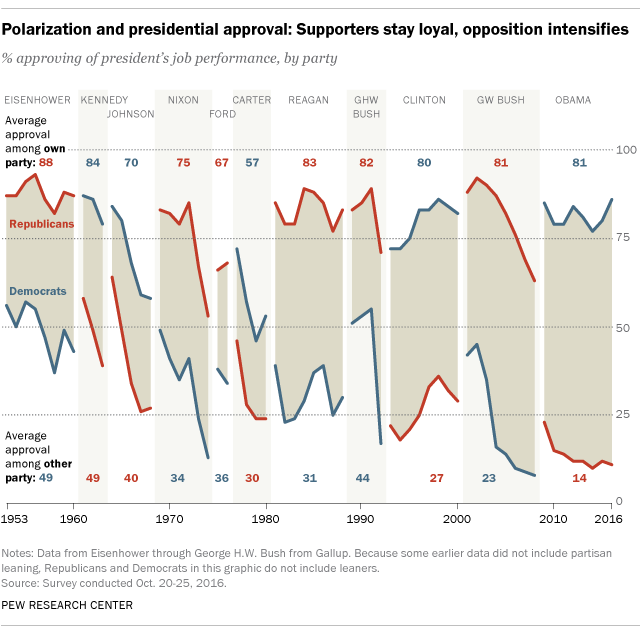A presidential campaign season that began early last year reaches its finale on Tuesday, as tens of millions of Americans go to their polling places to vote. As Election Day unfolds, here are five charts that highlight how politically polarized the nation has become — and how most Americans expect it to remain that way, regardless of who wins.
1Even before the current campaign began, the American public had grown more ideologically polarized along partisan lines, as Pew Research Center documented in a major study. As of 2015, 53% of Republicans and Republican-leaning independents had political values that were mostly or consistently conservative, up from 31% in 2004. While Republicans have shifted to the right, Democrats have shifted to the left: In 2015, 60% of Democrats and Democratic-leaning independents had values that were mostly or consistently liberal, compared with 49% in 2004 and just 30% in 1994. In addition to ideological polarization, partisan animosity also increased substantially during this period.

2Republicans and Democrats have grown increasingly negative in their evaluations of presidents representing the other party. Partisan divisions over presidential performance are wider now than at any point going back more than six decades, and this growing gap is largely the result of increasing disapproval of the chief executive from the opposition party. An average of just 14% of Republicans have approved of Barack Obama over the course of his presidency, compared with an average of 81% of Democrats.

3 Demographic changes have reshaped both party coalitions over the past quarter century, pushing them further apart. Democratic voters are becoming less white, less religious and better-educated at a faster rate than the country as a whole, while aging at a slower rate. Within the GOP, the pattern is the reverse: Republican voters are becoming more diverse, better-educated and less religious at a slower rate than the country generally, while the age profile of the GOP is growing older more quickly than that of the nation as a whole.
 4
4  Supporters of Hillary Clinton and Donald Trump differ sharply in their views of life in the U.S. today compared with the past. In August, 81% of Trump supporters said life in America today is worse for people like them than it was 50 years ago, compared with just 11% who said it is better.
Supporters of Hillary Clinton and Donald Trump differ sharply in their views of life in the U.S. today compared with the past. In August, 81% of Trump supporters said life in America today is worse for people like them than it was 50 years ago, compared with just 11% who said it is better.
Among Clinton supporters, about one-in-five (19%) said life is worse, compared with nearly six-in-ten (59%) who said it is better.
Meanwhile, Trump supporters were considerably more likely than Clinton voters (68% versus 30%) to say that the future of the next generation of Americans will be worse compared with life today.
5  Voters are skeptical that either Clinton or Trump will repair the country’s political divisions. No matter who wins on Tuesday, a strong majority of voters believe the nation’s polarization will remain a reality.
Voters are skeptical that either Clinton or Trump will repair the country’s political divisions. No matter who wins on Tuesday, a strong majority of voters believe the nation’s polarization will remain a reality.
Overall, 41% of voters say they expect political divisions in the country to increase if Clinton wins, while 48% say divisions will stay about the same and just 9% say they will decrease, according to an October survey. A majority of voters (55%) expect divisions to increase if Trump wins, while 26% say they will stay about the same and 17% say they will decrease.



